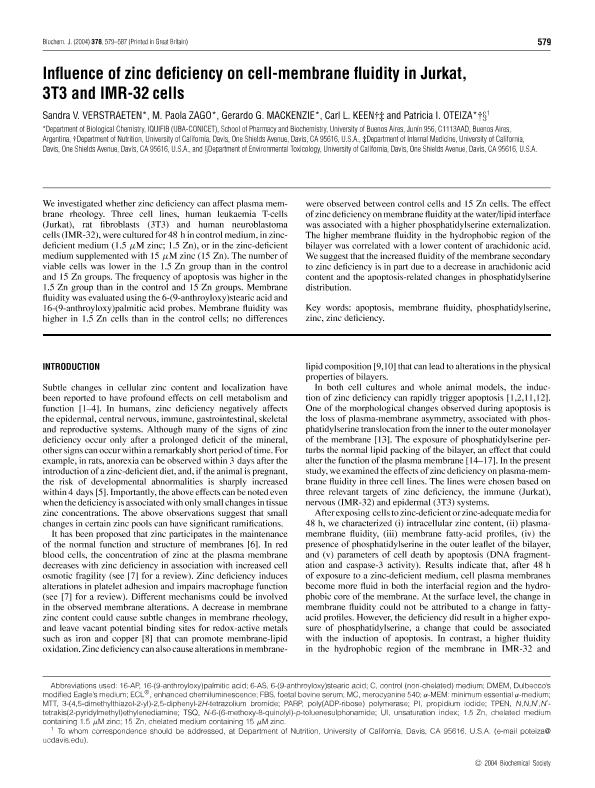Artículo
Influence of zinc deficiency on cell-membrane fluidity in Jurkat, 3T3 and IMR-32 cells
Verstraeten, Sandra Viviana ; Zago, María Paola
; Zago, María Paola ; Mackenzie, Gerardo G.; Keen, Carl L.; Oteiza, Patricia Isabel
; Mackenzie, Gerardo G.; Keen, Carl L.; Oteiza, Patricia Isabel
 ; Zago, María Paola
; Zago, María Paola ; Mackenzie, Gerardo G.; Keen, Carl L.; Oteiza, Patricia Isabel
; Mackenzie, Gerardo G.; Keen, Carl L.; Oteiza, Patricia Isabel
Fecha de publicación:
03/2004
Editorial:
Portland Press
Revista:
Biochemical Journal
ISSN:
0264-6021
Idioma:
Inglés
Tipo de recurso:
Artículo publicado
Clasificación temática:
Resumen
We investigated whether zinc deficiency can affect plasma membrane rheology. Three cell lines, human leukaemia T-cells (Jurkat), rat fibroblasts (3T3) and human neuroblastoma cells (IMR-32), were cultured for 48 h in control medium, in zinc-deficient medium (1.5 μM zinc; 1.5 Zn), or in the zinc-deficient medium supplemented with 15 μM zinc (15 Zn). The number of viable cells was lower in the 1.5 Zn group than in the control and 15 Zn groups. The frequency of apoptosis was higher in the 1.5 Zn group than in the control and 15 Zn groups. Membrane fluidity was evaluated using the 6-(9-anthroyloxy) stearic acid and 16-(9-anthroyloxy)palmitic acid probes. Membrane fluidity was higher in 1.5 Zn cells than in the control cells; no differences were observed between control cells and 15 Zn cells. The effect of zinc deficiency on membrane fluidity at the water/lipid interface was associated with a higher phosphatidylserine externalization. The higher membrane fluidity in the hydrophobic region of the bilayer was correlated with a lower content of arachidonic acid. We suggest that the increased fluidity of the membrane secondary to zinc deficiency is in part due to a decrease in arachidonic acid content and the apoptosis-related changes in phosphatidylserine distribution.
Palabras clave:
APOPTOSIS
,
MEMBRANE FLUIDITY
,
PHOSPHATIDYLSERINE
,
ZINC
,
ZINC DEFICIENCY
Archivos asociados
Licencia
Identificadores
Colecciones
Articulos(CCT - SALTA-JUJUY)
Articulos de CTRO.CIENTIFICO TECNOL.CONICET - SALTA-JUJUY
Articulos de CTRO.CIENTIFICO TECNOL.CONICET - SALTA-JUJUY
Citación
Verstraeten, Sandra Viviana; Zago, María Paola; Mackenzie, Gerardo G.; Keen, Carl L.; Oteiza, Patricia Isabel; Influence of zinc deficiency on cell-membrane fluidity in Jurkat, 3T3 and IMR-32 cells; Portland Press; Biochemical Journal; 378; 2; 3-2004; 579-587
Compartir
Altmétricas



